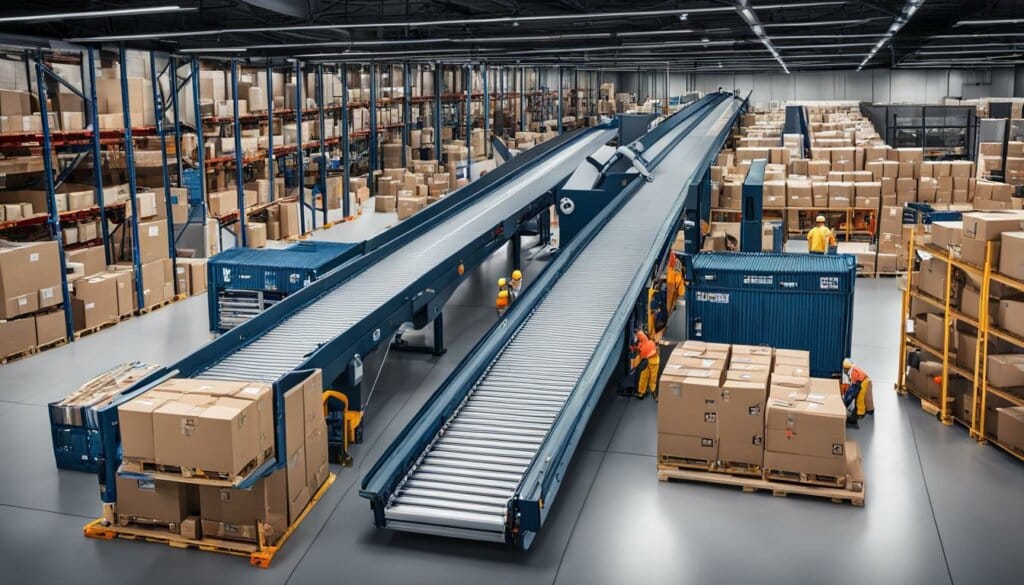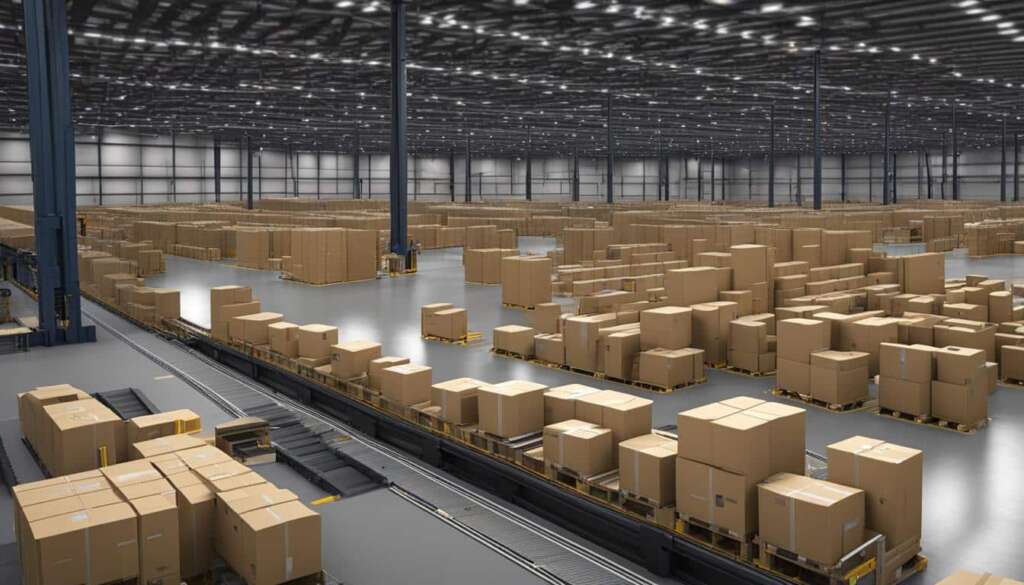Table of Contents
Today, e-commerce has revolutionized the way businesses operate, offering unparalleled convenience and accessibility to customers worldwide. However, behind every successful online store lies a well-optimized e-commerce supply chain. To truly thrive in the competitive digital landscape, businesses must streamline their supply chain operations, reduce costs, and prioritize customer satisfaction.
An efficient and well-managed e-commerce supply chain is key to achieving operational excellence and driving success in the online marketplace. By optimizing the various stages of the supply chain, businesses can enhance their capabilities, improve efficiency, and gain a competitive edge.
How an Efficient E-commerce Supply Chain Boosts Business
An efficient e-commerce supply chain offers several benefits to businesses. By optimizing their supply chain, companies can experience cost savings, reduced delays, increased transparency and visibility, effective multi-channel selling, improved customer relations, accurate forecasting, and insight into stock availability and inventory visibility.
One of the key advantages of an efficient e-commerce supply chain is cost savings. By streamlining operations, businesses can eliminate unnecessary expenditures, reduce waste, and optimize resource allocation. This results in lower costs and improved profitability.
In addition, an optimized supply chain minimizes delays and ensures timely delivery of products to customers. This enhances customer satisfaction and loyalty, leading to repeat purchases and positive word-of-mouth recommendations.
Furthermore, increased transparency and visibility in the supply chain enable businesses to gain a comprehensive overview of their operations. This facilitates better decision-making, as managers have access to real-time data and can identify areas for improvement or adjustment.
Effective multi-channel selling is another advantage of an efficient e-commerce supply chain. By seamlessly integrating various sales channels, businesses can reach a wider customer base and expand their market reach. This diversification enhances revenue streams and contributes to overall business growth.
Improved customer relations are a direct result of an efficient supply chain. By delivering products on time and providing accurate tracking information, businesses can build trust with customers and enhance their overall shopping experience. This leads to increased customer satisfaction and loyalty.
Accurate forecasting and insight into stock availability and inventory visibility enable businesses to optimize their inventory management. By having a clear understanding of demand patterns and stock levels, companies can avoid overstocking or shortages, reducing costs and ensuring efficient order fulfillment.
To achieve an efficient e-commerce supply chain, businesses can leverage software solutions and integrate e-commerce into their overall supply chain strategy. This allows for seamless collaboration with suppliers, procurement, and customers, resulting in streamlined operations, improved decision-making, and enhanced customer satisfaction.
“An efficient e-commerce supply chain is the backbone of successful online businesses. By optimizing their processes, companies can unlock new levels of efficiency, cost savings, and customer satisfaction.”
Benefits of an Efficient E-commerce Supply Chain
| Benefits | Description |
|---|---|
| Cost Savings | Optimized operations lead to reduced expenses and improved profitability. |
| Reduced Delays | Timely delivery of products enhances customer satisfaction and loyalty. |
| Increased Transparency and Visibility | Real-time data allows for better decision-making and process optimization. |
| Effective Multi-channel Selling | Integration of various sales channels expands market reach and diversifies revenue streams. |
| Improved Customer Relations | Timely delivery and accurate tracking enhance customer satisfaction and loyalty. |
| Accurate Forecasting and Inventory Visibility | Insight into stock availability and demand patterns improves inventory management. |
By embracing the power of an efficient e-commerce supply chain, businesses can boost their performance, maximize profitability, and gain a competitive edge in the online marketplace.
Stages of an E-commerce Supply Chain
The e-commerce supply chain consists of several stages that are crucial for efficient operations and customer satisfaction. Let’s explore each stage in detail:
1. Market Analysis for Optimal Product Selection
In the first stage of the e-commerce supply chain, businesses analyze market supply and demand to determine the optimal product selection. This involves researching customer preferences, identifying trending products, and conducting competitor analysis. By understanding market dynamics, businesses can strategically choose products that align with customer needs and have high demand, optimizing their product assortment and enhancing sales.
2. Warehousing and Inventory Management
In the second stage, warehousing and inventory management play a crucial role. This includes receiving, storing, and distributing goods efficiently. Businesses must organize their warehousing facilities to ensure easy accessibility, proper storage conditions, and streamlined workflows. Accurate inventory management is vital to avoid stockouts or excess inventory, reduce holding costs, and ensure timely order fulfillment.
3. Order Entry and Management
During the third stage, order entry and management processes come into play. Businesses need efficient systems to record and coordinate orders effectively throughout the fulfillment process. This involves managing customer information, tracking inventory availability, and coordinating order fulfillment across different channels and locations. By streamlining order management, businesses can ensure accurate and timely order processing, leading to improved customer satisfaction.
4. Distribution, Delivery, and Returns
The final stage of the e-commerce supply chain encompasses distribution, delivery, and returns. This stage involves shipping products to customers in a timely and cost-effective manner while ensuring efficient handling of returns. Businesses need robust logistics and transportation systems to manage product distribution across various locations. By providing reliable and efficient delivery options, businesses can enhance customer experience and maintain customer loyalty.
| Stage | Description |
|---|---|
| Market Analysis for Optimal Product Selection | Determining the best product selection based on market demand and customer preferences. |
| Warehousing and Inventory Management | Receiving, storing, and distributing goods efficiently while accurately managing inventory. |
| Order Entry and Management | Recording and coordinating orders throughout the fulfillment process to ensure timely and accurate order processing. |
| Distribution, Delivery, and Returns | Shipping products to customers, managing deliveries, and handling returns efficiently. |
“Efficiently managing each stage of the e-commerce supply chain is vital for businesses to meet customer expectations, reduce costs, and drive growth. By optimizing market analysis, warehousing, order management, and distribution processes, businesses can create a seamless customer experience and gain a competitive edge in the e-commerce landscape.”
E-commerce Supply Chain Challenges to Watch Out For
The e-commerce supply chain poses various challenges that businesses need to be aware of in order to effectively navigate this complex landscape. Overcoming these challenges requires a deep understanding of the nuances of e-commerce operations and the implementation of dedicated systems and solutions that can streamline processes and optimize operations. Here are some key challenges that businesses must watch out for:
1. Inventory Management Complexity
As e-commerce businesses scale and deal with a wide range of products, managing inventory becomes a complex task. Increasing SKUs (Stock Keeping Units) and barcodes make it challenging to accurately track and manage stock levels. Inefficient inventory management can lead to stockouts, overstocking, and inaccurate order fulfillment, ultimately resulting in customer dissatisfaction and lost sales.
2. Warehouse Sorting for Multiple Channels and Warehouses
E-commerce businesses often handle multiple sales channels and warehouses to meet customer demands. This poses a challenge in terms of efficient warehouse sorting and management. The need to accurately pick and sort products for different channels and warehouses can lead to increased labor costs, delayed order fulfillment, and potential inventory mix-ups.
3. Transportation Logistics Planning and Management
Transportation logistics play a critical role in the success of an e-commerce supply chain. Ensuring timely and cost-effective delivery to customers requires careful planning and management of transportation routes, carrier selection, and delivery tracking. Poor logistics management can result in delayed deliveries, increased shipping costs, and a negative impact on customer satisfaction.
To address these challenges, businesses need to leverage dedicated systems and solutions that automate key processes, improve visibility across the supply chain, and optimize operations. Advanced inventory management software, warehouse management systems, and transportation management systems can provide real-time visibility into stock levels, simplify warehouse operations, and streamline transportation logistics.
“Streamlined inventory management, efficient warehouse sorting, and optimized transportation logistics are essential to overcome the challenges of the e-commerce supply chain.”
By proactively addressing these challenges and implementing the right solutions, e-commerce businesses can enhance their supply chain operations, reduce costs, and improve customer satisfaction. Successful navigation of these challenges will position businesses for sustained growth and success in the competitive e-commerce landscape.
Tips for an Effective E-commerce Supply Chain
Optimizing the e-commerce supply chain is crucial for the success of online businesses. By implementing the following effective e-commerce supply chain tips, businesses can streamline operations, reduce costs, and enhance customer satisfaction.
- Audit the current supply chain: Conduct a thorough analysis of the existing supply chain to identify inefficiencies and areas for improvement. This enables businesses to make data-driven decisions and implement effective solutions to optimize the supply chain.
- Implement automated order processing: By automating order processing tasks, businesses can reduce manual work, improve efficiency, and accelerate the fulfillment process. This helps minimize errors, streamline operations, and enhance customer satisfaction.
- Work with a shipping service provider: Collaborating with a reliable shipping service provider can simplify logistics and alleviate the burden of inventory management. Outsourcing shipping operations allows businesses to focus on core competencies while ensuring timely and cost-effective delivery.
- Strategically map out the warehouse: Efficiently organizing the warehouse and strategically mapping inventory locations can improve organization and enhance operational efficiency. This enables businesses to reduce picking and packing time, optimize space utilization, and minimize errors.
- Embrace omnichannel commerce: Selling across multiple channels, such as online marketplaces, social media platforms, and physical stores, enables businesses to reach a wider audience and maximize sales opportunities. Embracing omnichannel commerce requires effective inventory management and seamless integration between different sales channels.
By implementing these effective e-commerce supply chain tips, businesses can optimize their operations, improve customer satisfaction, and gain a competitive edge in the online marketplace.

“The ultimate goal of supply chain optimization is to create value for customers.” – Dave Waters
The Role of Supply Chain Optimization in E-commerce Growth
Supply chain optimization is a critical factor in driving the growth of e-commerce businesses. By continuously improving the supply chain through network design, optimization, and simulation, businesses can achieve efficient operations, reduce costs, and enhance customer satisfaction. The implementation of various initiatives plays a crucial role in overall supply chain optimization and business growth.
Full Visibility
Having complete visibility throughout the supply chain is essential for optimizing operations and making informed decisions. By leveraging real-time data and advanced analytics, businesses can gain insights into inventory levels, demand patterns, and supplier performance. With full visibility, companies can proactively identify bottlenecks, optimize inventory levels, and improve overall supply chain efficiency.
Cost Reduction Mechanisms
Cost reduction is a key driver of supply chain optimization. By identifying cost-saving opportunities and implementing efficient processes, businesses can minimize expenses and improve profitability. This can be achieved through strategies such as demand forecasting, inventory optimization, lean manufacturing, and transportation optimization. By streamlining operations and reducing unnecessary costs, businesses can allocate resources effectively and drive growth.
Productivity-Centered Strategies
Optimizing the efficiency and productivity of supply chain operations is critical for e-commerce growth. Businesses can implement strategies such as automation, process optimization, and performance monitoring to enhance productivity levels. By leveraging technology solutions and digital tools, businesses can streamline workflows, reduce manual errors, and improve overall operational efficiency.
Built-in Profit Considerations
Supply chain optimization should be aligned with profit objectives. Businesses need to consider profit margin targets at each stage of the supply chain and make informed decisions accordingly. By analyzing the cost-to-serve and profitability of different products and customer segments, businesses can prioritize high-profit channels and optimize their supply chain to maximize revenue.
Safety-First Approaches
Maintaining product integrity and ensuring safety is crucial within the e-commerce supply chain. By implementing rigorous quality control processes, adhering to industry safety regulations, and conducting regular audits, businesses can build trust with customers and mitigate the risk of product recalls or safety incidents. Safety-first approaches help enhance customer satisfaction and protect the brand reputation.
Customer-Centric Marketing
A customer-centric approach is essential for driving e-commerce growth. By aligning marketing strategies with the needs and preferences of target customers, businesses can create personalized experiences and build long-term relationships. Understanding customer demands and optimizing supply chain operations accordingly can lead to improved order fulfillment, faster delivery, and increased customer loyalty.
Flexibility
The ability to adapt and respond to changing market dynamics is crucial for e-commerce growth. Businesses should build flexibility into their supply chain to accommodate fluctuations in demand, disruptions in supply, or changes in customer preferences. By leveraging advanced forecasting models, collaborative planning, and agile inventory management, businesses can optimize operations and seize opportunities for growth.
Reliable Suppliers
Strong partnerships with reliable suppliers are essential for supply chain optimization. By collaborating with suppliers who have a track record of on-time delivery, quality products, and effective communication, businesses can minimize disruptions and ensure a smooth supply chain flow. A robust supplier management system and regular performance reviews can help identify and address any gaps or inefficiencies.
By incorporating these strategies and initiatives, businesses can optimize their supply chain and drive e-commerce growth. Supply chain optimization enables efficient operations, cost savings, improved customer satisfaction, and increased competitiveness in the dynamic e-commerce landscape.
The Power of Network Design for E-commerce Supply Chains
Network design plays a crucial role in optimizing e-commerce supply chains. By leveraging network design tools like optimization and simulation software, businesses can make data-driven decisions, accurately predict outcomes, and identify areas for improvement. These tools create a risk-free environment to model supply chain operations, run scenarios, and compare different outcomes. By continuously refining and optimizing the network design, businesses can stay ahead of changing market conditions, enhance service levels, reduce costs, and ensure long-term sustainability.
Benefits of Network Design in E-commerce Supply Chains
E-commerce businesses can reap several benefits from implementing network design strategies:
- Improved Efficiency: Network design enables businesses to optimize their distribution network, reducing the distance between warehouses and customers. This results in faster and more cost-effective delivery, enhancing overall operational efficiency.
- Enhanced Service Levels: By strategically locating warehouses and distribution centers, businesses can ensure timely order fulfillment, leading to improved customer satisfaction and retention.
- Reduced Costs: Optimizing the network design helps businesses identify opportunities for cost savings, such as optimizing transportation routes, consolidating shipments, and minimizing inventory carrying costs.
- Better Risk Management: Through network design simulations, businesses can evaluate the impact of disruptions and develop contingency plans to mitigate risks. This enhances the resilience of the supply chain and minimizes potential disruptions.
Utilizing network design tools empowers businesses to make informed decisions based on real data and take proactive measures to optimize their e-commerce supply chains.
Network design provides businesses with the ability to strategically plan and execute their supply chain operations, ultimately driving performance, reducing costs, and enhancing customer satisfaction.
Example: Network Design in E-commerce

Image: Illustration of a network design plan for an e-commerce supply chain
To better understand how network design works in an e-commerce context, consider the example of a global online retailer looking to expand its presence in Europe. The company uses network design tools to analyze various factors such as customer demand, order patterns, transportation costs, and warehouse capacities. Based on this data, the company can strategically determine the optimal number and location of warehouses to serve its European customer base efficiently.
| Benefits of Optimized Network Design in E-commerce | Challenges Addressed |
|---|---|
| Reduced shipping costs | High transportation costs due to inefficient network |
| Faster delivery times | Delays caused by long distances between warehouses and customers |
| Improved customer satisfaction | Inaccurate order fulfillment and longer lead times |
The table above highlights the benefits of an optimized network design in e-commerce and the corresponding challenges that can be addressed. By strategically designing the network, businesses can overcome these challenges and create a more efficient and customer-centric supply chain.
Conclusion
In conclusion, the optimization of the e-commerce supply chain is crucial for the success of online businesses. By implementing efficient operations, automation, strategic partnerships, and a continuous improvement mindset, businesses can streamline their supply chain processes, reduce costs, and ultimately enhance customer satisfaction.
With the right tools and a data-driven approach, businesses can optimize their network design, ensuring improved visibility and better-informed decision-making. This enables them to achieve operational excellence and drive growth in the highly competitive e-commerce landscape.
By embracing strategies that focus on supply chain optimization, businesses can position themselves at the forefront of the industry. Through seamless operations, cost reduction, and customer-centric approaches, they can not only survive but thrive in the ever-evolving e-commerce market.
FAQ
What is the importance of optimizing the e-commerce supply chain?
Optimizing the e-commerce supply chain is crucial for businesses as it helps streamline operations, reduce costs, and improve customer satisfaction. It allows businesses to achieve operational excellence and stay ahead in the competitive online marketplace.
What are the benefits of having an efficient e-commerce supply chain?
An efficient e-commerce supply chain offers several benefits to businesses including cost savings, reduced delays, increased transparency and visibility, effective multi-channel selling, improved customer relations, accurate forecasting, and insight into stock availability and inventory visibility.
What are the stages of an e-commerce supply chain?
The stages of an e-commerce supply chain include analyzing market supply and demand, warehousing and inventory management, order entry and management, and distribution, delivery, and returns.
What are some challenges faced in the e-commerce supply chain?
Challenges in the e-commerce supply chain include complex inventory management, warehousing and sorting difficulties due to multiple channels and warehouses, and the need for careful planning and management in transportation logistics.
How can businesses optimize their e-commerce supply chain?
Businesses can optimize their e-commerce supply chain by auditing the current supply chain, implementing automated order processing, working with a shipping service provider, strategically mapping out the warehouse and inventory distribution, and embracing omnichannel commerce.
What is the role of supply chain optimization in e-commerce growth?
Supply chain optimization plays a vital role in the growth of e-commerce businesses as it ensures efficient operations, lower costs, and higher customer satisfaction. It involves initiatives such as full visibility, cost reduction mechanisms, productivity-centered strategies, and reliable suppliers.
How does network design contribute to optimizing e-commerce supply chains?
Network design is a powerful tool for optimizing e-commerce supply chains as it allows businesses to accurately predict outcomes, identify improvement opportunities, and make data-driven choices. It helps improve service levels, reduce costs, and ensure long-term sustainability.
What is the importance of optimizing the e-commerce supply chain?
Optimizing the e-commerce supply chain is essential for the success of online businesses as it streamlines operations, reduces costs, and enhances customer satisfaction. It leads to efficient operations, automation, strategic partnerships, and continuous improvement.













